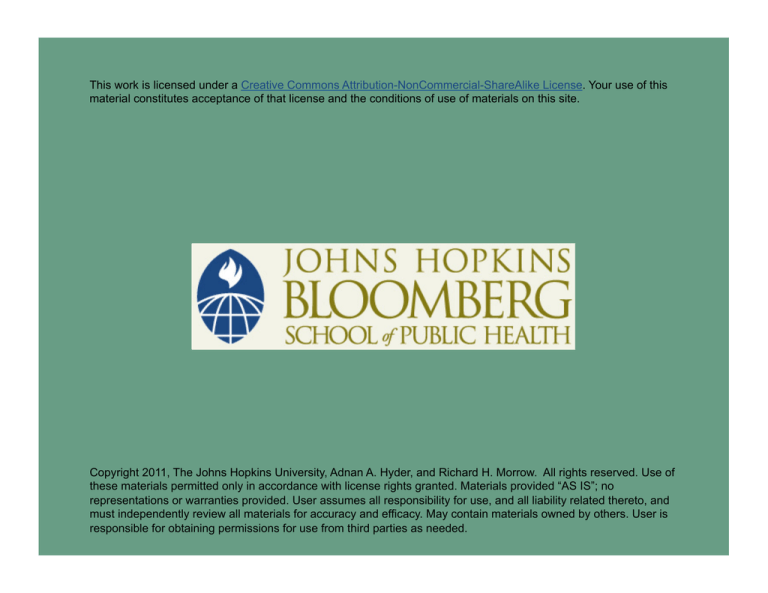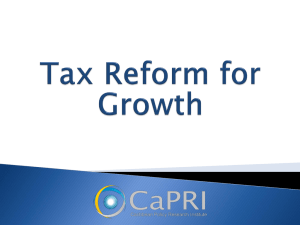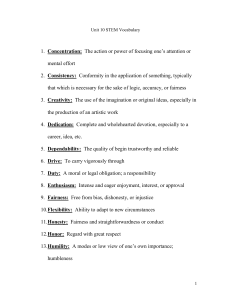
This work is licensed under a Creative Commons Attribution-NonCommercial-ShareAlike License. Your use of this
material constitutes acceptance of that license and the conditions of use of materials on this site.
Copyright 2011, The Johns Hopkins University, Adnan A. Hyder, and Richard H. Morrow. All rights reserved. Use of
these materials permitted only in accordance with license rights granted. Materials provided “AS IS”; no
representations or warranties provided. User assumes all responsibility for use, and all liability related thereto, and
must independently review all materials for accuracy and efficacy. May contain materials owned by others. User is
responsible for obtaining permissions for use from third parties as needed.
Section B: Benchmarks of Fairness
for Health Care Reform
Adnan A. Hyder, MD, PhD, MPH
Fairness: A Tool for Development?
Norman Daniels—professor of philosophy and population health,
Harvard School of Public Health
1985: Just Health Care
1988: Am I My Parent’s Keeper?
1993: Clinton Health Care Task Force
-
Ethics Working Group develop principles to govern the design
of the comprehensive health insurance reform being developed
-
Daniels Light and Caplan. (1996). Benchmarks of fairness for
health care reform. Oxford Press.
Latest: Just Health
3
Fairness: A Tool for Development?
Reform in the US became a politically dead issue (mid-1990s), but
the Benchmarks were not!
1998: the Benchmarks went international, and soon workshops
involving Pakistan, Thailand, Cameroon, Mexico, and Colombia
Daniels, Bryant, et al. (2000, June). Benchmarks of fairness for
health care reform: A policy tool for developing countries. WHO
Bulletin.
4
The Meaning of Fairness
The concept of fairness is broad, including concerns about:
- Equity
-
-
-
Efficiency
Accountability
Empowerment
Indeed, fairness is equivalent to social justice
5
Trends in Health Care Reform
Internationally, there is increasing attention to problems of
governance/accountability that must be addressed by reforms,
however:
-
There is little publicly available information about the
performance of health units and hospitals
-
There is an absence of civic groups to insist on service to those
most in need
-
Underpayment of personnel encourages various forms of
corruption (among other factors)
6
Trends in Reform (2)
These shifts in strategy are welcome, but there remains a weakness
in integrating these key goals of fairness:
-
-
-
Equity
Accountability
Efficiency
And in evaluating what effects reforms actually have on them
7
Benchmarks of Fairness for Health Care Reform
The Benchmarks aim to help fill these gaps by translating general
ethical ideas about social justice or fairness into locally agreed
upon, specific criteria and operational measures of their relative
satisfaction
This approach provides the integrating framework for fairness that
has been lacking and a method for gathering evidence about the
effects of reform on elements of the framework
8
The Adapted Benchmarks
1. Intersectoral public health
2. Financial barriers to equitable access
3. Nonfinancial barriers to access
4. Comprehensiveness of benefits, tiering
5. Equitable financing
6. Efficacy, efficiency, quality of health care
7. Administrative efficiency
8. Democratic accountability, empowerment
9. Patient and provider autonomy
9
Connections to Social Justice
Equity
- B1 intersectoral public health
-
B2-3 access, B4 tiering, B5 financing
Efficiency
- B6 clinical efficacy and quality
- B7 administrative efficiency
Democratic accountability
- B8, B9 choice
10
Structure of BMs
B1-9 main goals
- Criteria—key aspects
Sub-criteria—main means or elements
Evidence base + evaluation
- Indicators (role of SMPH)
- Scoring rules
11
B1: Intersectoral Public Health
Degree to which reform increases percent of population with:
- Basic nutrition, adequate housing, clean water, air, workplace
protection, education and health education (various types),
public safety and violence reduction
Information infrastructure for monitoring health status inequities
Degree to which reform engages in active intersectoral effort,
including social determinants
12
B2: Financial Barriers to Access
Non-formal sector
- Universal access to appropriate basic package
-
-
Drugs
Medical transport
Formal sector social/private insurance
- Encourages expansion of prepayment
- Family coverage
- Drug, medical transport
- Integrate various groups, uniform benefits
13
B3: Non-financial Barriers to Access
Reduction of geographical maldistribution of facilities, services,
personnel, etc.
Gender issues
Cultural—language, attitude to disease, uninformed reliance on
traditional practitioners
Discrimination—race, religion, class, sexual orientation, disease
14
B6: Efficacy, Efficiency, and Quality of Health Care
Primary health care focus
- Population based, outreach, community participation,
integration with system, incentives, appropriate resource
allocation
Implementation of evidence-based practice
- Health policies, public health, therapeutic interventions
Measures to improve quality
- Regular assessment, accreditation, training
15
B8: Democratic Accountability and Empowerment
Explicit public detailed procedures for evaluating services, full
public reports
Explicit deliberative procedures for resource allocation
(accountability for reasonableness)
Fair grievance procedures, legal, non-legal
Global budgeting
Privacy protection
Enforcement of compliance with rules, laws
Strengthening civil society: advocacy-debate
16
Scoring Benchmarks
Reform relative to status quo
17
Why Is Evidence Base Important?
Evidence base makes evaluation objective
Making evaluation objective means ...
- Explicit interpretation of criteria
- Explicit rules for assessing whether criteria are met and the
degree to which alternatives meet them
Objectivity provides basis for policy deliberation
- Gives points of disagreement a focus that requires reasons and
evidence
-
Use of burden of disease/SMPH and CEA
18
The Adapted Benchmarks
1. Intersectoral public health
2. Financial barriers to equitable access
3. Nonfinancial barriers to access
4. Comprehensiveness of benefits, tiering
5. Equitable financing
6. Efficacy, efficiency, quality of health care
7. Administrative efficiency
8. Democratic accountability, empowerment
9. Patient and provider autonomy
19
Reflections: 1
The possibility of the concept of fairness being incorporated into a
framework which can be used to enhance the health of the people
of a nation
The process can be adapted to the special and possibly unique
circumstances of each nation (or of a sub-national component)
It is possible that multiple countries and their societies will find this
process helpful as they pursue the process of health sector reform
20
Reflections: 2
There will be the possibility of sharing experiences among countries
on a regional and global basis
The use of evidence in this assessment is critical and called for by
repeated applications around the world
The ability to count all dimensions of health is important for this
dialogue
21
But There Is a Lot More
It will require a whole course for this discussion
Many thanks to Norman Daniels, Jack Bryant, and colleagues in
Colombia, Pakistan, Thailand, and other countries
22






